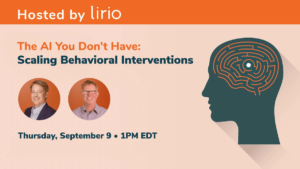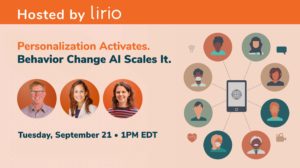Updated December 2, 2021
The identification of the COVID-19 Omicron variant has the global health community scrambling to re-examine their treatment and vaccine strategies, reminding us how fluid and interconnected our response is to this virus. One takeaway that has become painfully clear is the vulnerability that remains the longer we go without vaccinating the eligible population.
To reduce the risk of increasingly transmissible or immune-evasive variants, we must overcome issues of hesitancy and equity to increase vaccination rates. Additionally, we must communicate clearly and decisively about recommendations for newly eligible children and booster timelines.
Lirio launched a vaccination solution in early 2021 to leverage behavioral science personalized by AI in overcoming a range of vaccine-related barriers and has delivered millions of unique behavioral interventions since. In that time, we’ve learned how important these strategies are for communicating effectively. We’ve also learned a few other things that are timely as we ramp up outreach among rising case numbers and in preparation of an Omicron spike.
- Interestingly, getting fully vaccinated is not a single behavior. We found different behavioral interventions motivated the three different behaviors of the vaccination journey—appointment scheduling, follow-through for dose 1, and follow-through for dose 2. We expect this same pattern to hold for scheduling and obtaining a booster dose, as well as future booster doses that may be required.
- Words matter, but context matters more. In an environment that has become emotionally charged, a text message activates a stronger reaction than an email. Text messaging also carries other considerations like parent/child phone ownership, shared or inherited mobile numbers, and a greater lack of familiarity with unsubscribe procedures.
- Precision Nudging™ works—Lirio’s approach has been equally effective with traditionally hard-to-engage or vaccine-hesitant patients across race, economic status, and political affiliation.
Examining our results suggest when people are deciding whether to receive a COVID-19 vaccination and determining the logistics of doing so, their primary barriers may be related to lack of information or education, both regarding the vaccine in general and how to obtain it. Once a person is informed, decides to receive the vaccine, and solves the practical issues associated with doing so, the primary barriers become more social and motivational.
These findings are consistent with and build on prior work around vaccination behavior. For example, past research has established the importance of educational tactics when people lack knowledge or confidence in a vaccine, and logistical support when people have positive vaccine intentions, but have not taken action. The ability to scale effective, personalized interventions will be a critical weapon in the quest to overcome COVID-19.
When the Delta variant caused a surge in COVID-19 cases, hospitalizations, and deaths around the country just a few short months ago, health systems and public health organizations continued to face challenges with moving patient populations toward vaccination. As the virus is more likely to mutate in places where vaccination is low and transmission high, the emergence of Omicron bears out the consequences of being slow to vaccinate.
With FDA authorization of the vaccine for children 5 years and up, there are now an estimated 111.9 million people in the U.S. eligible for the vaccine who have not received it. The Peterson-KFF Health System Tracker reports COVID-related hospitalizations among unvaccinated people range from 95% to 99.9% by state. Because this group faces the highest risk of contracting the virus and experiencing severe illness, there is a great sense of urgency to increase vaccine adoption nationwide.
Though the COVID-19 vaccine has introduced a new set of cognitive barriers related to vaccination, vaccine hesitancy is not a new concept and has been around as long as vaccines themselves. In fact, individuals resisted mandatory vaccines during the smallpox era when the Anti-Vaccination Society of America was founded. The Centers for Disease Control and Prevention (CDC) now honors National Immunization Awareness Month every August to share information about the importance of vaccination for public health and the safety and efficacy of vaccines.
What’s Holding People Back from the COVID-19 Vaccine?
There are as many reasons for not getting vaccinated as there are people not getting vaccinated. Each person who opts not to receive the COVID-19 vaccine has their own experiences, world views, and decision-making processes – all of which contribute to their choice.
On one hand, many people have strong feelings of fear and uncertainty around the safety of the vaccines. A Census Household Pulse Survey published in The New York Times found the top two reasons given for not yet getting a shot are: “side effects” (53%) and “waiting to see if it’s safe” (40%). The novelty of the virus and the expedited release of the vaccines have created a series of unknowns that only increase hesitancy.
Another significant barrier to vaccination is access, as many people have life circumstances that do not allow them to easily receive the vaccine. In an interview with The Atlantic, Dr. Rhea Boyd, a pediatrician and public health advocate in the San Francisco Bay area, described some of these as: no internet access, lack of transportation, inflexible work hours, inadequate sick leave, and lack of childcare. According to Boyd, while the Biden administration has organized programs to address these needs, they haven’t all filtered down to the local level.
Additionally, the pandemic has shed light on a series of social and behavioral issues that impact people’s responses to guidance related to virus prevention, including but not limited to: threat perception, social context, science communication, aligning individual and collective interests, leadership, and stress and coping. These issues affect everyone differently and must be taken into consideration when assessing vaccine hesitancy.
No matter what your patients’ reasons are for not getting vaccinated, reaching them with the right message at the right time will require a tailored communication approach.
How You Communicate Matters
In The Atlantic interview, Dr. Rhea Boyd continued: “The language we use around unvaccinated people comes with a judgment–a condescension that ‘you’re unvaccinated and it’s your choice at this point’…But vaccinated people aren’t a random group of defectors who are trying to be deviant.”
Healthcare providers need to understand these individual barriers to vaccination to identify solutions and communicate effectively with patients. This involves learning their social determinants of health (SDOH) and the cognitive biases related to the vaccine. With this knowledge, healthcare organizations can improve health equity and expand access to the vaccine through alternative care routes.
Additionally, building real, personal relationships with patients will set your organization up for success. That’s what happened in Macon County, Alabama, where School District Superintendent, Jacqueline Brooks, led the district’s custodians, bus drivers, and lunchroom workers to universal vaccination in part by engaging in personal conversations that acknowledged the risks, ensured people were comfortable, and offered reassurance and data.
It’s important to deliver messages about getting the vaccine in ways that resonate on an individual basis. The combination of SDOH data, personalized behavioral insights, and carefully crafted language informs not only what you say to patients, but how you say it – which goes a long way in moving them to take action.
The Dos and Don’ts of Vaccine Communication
There are a few best practices to keep in mind when crafting patient-centered messages regarding the COVID-19 vaccine and booster shot. Consider these dos and don’ts as part of your healthcare organization’s communication strategy.
1. Don’t Use Blaming Language
People are complex, and their reasons for not getting vaccinated are almost always multifaceted. Recognize each patient’s humanity and all the factors at play in their approach to health decisions.
Assume the best in your patients and avoid messages that could put them on the defensive about their vaccination decision. This starts with how your organization communicates internally about patients who aren’t vaccinated and extends to every external channel used to share information about the vaccine.
2. Do Make Patients Feel Known
Lead with empathy and understanding. Ensure patients feel known and cared for by your organization by providing critical information and solutions aimed at easing their concerns and removing barriers to vaccine access.
Prompt patients with questions related to SDOH to collect data around potential life circumstances that could keep them from vaccination. Then, create personalized messages that address these barriers and highlight alternative options they can pursue. Additionally, your messages should affirm your organization’s commitment to the safety and wellbeing of all patients, so you can build trust around the vaccine initiative.
The patient’s relationship with their primary care physician is critical to effectively executing this communication approach. In a recent AL.com article, Dr. Brytney Cobia, a hospitalist at Grandview Medical Center in Birmingham, Alabama, shared about treating unvaccinated COVID-19 patients. “And the one question I always ask them is, did you make an appointment with your primary care doctor and ask them for their opinion on whether or not you should receive the vaccine? And so far, nobody has answered yes to that question.”
By encouraging patients to contact their primary care physician (or establish a primary care physician) you can help foster this personal relationship with a trusted professional – who knows and understands them – to answer questions and provide guidance.
3. Do Keep the Digital Front Door Wide Open
The digital health revolution brought on by the pandemic has made it easier than ever for patients to communicate and share information with their providers. Now is the time to really lean into your tech solutions and realize value from your investments. These tools help remove barriers in communication that may have previously kept your patients from reaching out for information about the vaccine.
According to a nationally representative survey conducted in June and July 2020 for The Pew Charitable Trusts, about four in 10 survey respondents said the pandemic made them more likely to support efforts that enable data-sharing among a patient’s providers and let people download their personal data from EHRs to apps on smartphones and other devices.
Your patients want easy access to their health information and easier communication across the continuum of care. When communication and information sharing is seamless, accurate, and personalized, they can feel empowered to make the right decisions for their health.
Lirio Supports Vaccine Adoption with Precision Nudging™
Earlier this year, Lirio launched a Precision Nudging™ solution to encourage COVID-19 vaccine acceptance among patient populations, and partnered with Franciscan Missionaries of Our Lady Health System (FMOLHS) to support vaccine initiatives throughout Louisiana.
Our behavior change AI platform uses Precision Nudging™ to apply behavioral interventions to patient communications through digital communication channels like email, text, or even through a patient portal. The result is hyper-personalized messages that overcome cognitive barriers and move patients to make healthy decisions – including scheduling appointments for and receiving the COVID-19 vaccine.
Lirio’s Precision Nudging™ is not only increasing COVID-19 vaccination rates among recipients as a whole, but our approach has been particularly effective for members of groups who tend to be more vaccine-hesitant, including people of color, people in lower income brackets, and people with conservative political affiliations. This surprising pattern of results speaks to the power of personalizing communication to address people’s individual barriers. With Precision Nudging™, Lirio helps some of the most vulnerable and entrenched populations overcome barriers to action.
To learn more about Lirio, we invite you to join one of our upcoming webinars:
The AI You Don’t Have: Scaling Behavioral Interventions

September 9 at 1pm EST
Speaker: Chris Symons, Ph.D., Chief Artificial Intelligence Scientist
Personalization Activates. Behavior Change AI Scales It.

September 21 at 1pm EST
Speakers: Chandra Osborn, Ph.D., Chief Behavioral Officer, Amy Bucher, Ph.D., Vice President of Behavioral Design
Follow Lirio on Facebook: Facebook.com/lirio.llc, LinkedIn: LinkedIn.com/company/lirio, and Twitter: @Lirio_LLC.
Other readers viewed:
Lirio Launches Hyper-Personalized Vaccination Journey to Encourage Vaccine Adoption
How to Make Patient-Centered Care Sustainable
How Behavior Change AI Addresses SDOH
How to Connect with Patients as Individuals: 10 Behavioral Biases Health Systems Should Know
